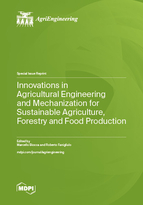Innovations in Agricultural Engineering and Mechanization for Sustainable Agriculture, Forestry and Food Production
A special issue of AgriEngineering (ISSN 2624-7402).
Deadline for manuscript submissions: closed (31 January 2024) | Viewed by 20508
Special Issue Editors
Interests: agricultural engineering; safety, health and safety in agro-food systems; crop protection technology; mechanization in urban forestry
Special Issues, Collections and Topics in MDPI journals
Interests: agricultural engineering; prototypes development; testing of farm machinery, forestry equipment’s and tires; study of biolubricants; circular economy
Special Issue Information
Dear Colleagues,
The aim of this Special Issue is to collect manuscripts related to engineering applications to promote sustainable agriculture.
Agricultural engineering and sustainable development are intrinsically linked, and all fields of agricultural engineering have a great potential to enhance the global sustainability, from the development and use of innovative machinery to the latest application of digital- and precision-farming solutions. Agricultural engineering and mechanization play a key role in developing bio-based input, in waste process and treatment to reduce the greenhouse gas emissions, in reducing and correctly distributing pesticides and fertilizers.
Agriculture, forestry, and food-production must continue to supply safe and healthy food, feed, and fibers without draining non-renewable resources or compromising the environment, assuring economic profitability, and social and economic equity and contributing to achieve the United Nations sustainable development goals, the European Green Deal, and the Farm to Fork Strategy.
This Special Issue focuses, but is not limited, to the agricultural engineering in the following areas:
- Sustainable technology innovation to support resource efficiency;
- Energy conservation and low-carbon production;
- Organic farming;
- LCA;
- Sustainable supply chain management;
- Sustainable material development and evaluation;
- Agro-waste minimisation, reuse and recycling technologies;
- Agricultural engineering solutions for developing countries;
- Agricultural machinery, equipment, and structures;
- Agricultural resource management (including land-use and water-use);
- Agro-food waste management;
- Biofuels and renewable energies;
- Energy efficiency and conservation;
- ICT, digital, and precision agriculture;
- Livestock and aquaculture production;
- Soil management and conservation;
- Sustainable postharvest management practices;
- Water management and irrigation techniques;
- Fruit crops and agro-biodiversity preservation.
Dr. Marcello Biocca
Dr. Roberto Fanigliulo
Guest Editors
Manuscript Submission Information
Manuscripts should be submitted online at www.mdpi.com by registering and logging in to this website. Once you are registered, click here to go to the submission form. Manuscripts can be submitted until the deadline. All submissions that pass pre-check are peer-reviewed. Accepted papers will be published continuously in the journal (as soon as accepted) and will be listed together on the special issue website. Research articles, review articles as well as short communications are invited. For planned papers, a title and short abstract (about 100 words) can be sent to the Editorial Office for announcement on this website.
Submitted manuscripts should not have been published previously, nor be under consideration for publication elsewhere (except conference proceedings papers). All manuscripts are thoroughly refereed through a single-blind peer-review process. A guide for authors and other relevant information for submission of manuscripts is available on the Instructions for Authors page. AgriEngineering is an international peer-reviewed open access quarterly journal published by MDPI.
Please visit the Instructions for Authors page before submitting a manuscript. The Article Processing Charge (APC) for publication in this open access journal is 1600 CHF (Swiss Francs). Submitted papers should be well formatted and use good English. Authors may use MDPI's English editing service prior to publication or during author revisions.
Keywords
- sustainable agriculture
- precision farming
- organic farming
- circular economy
- pollution
- input reduction







